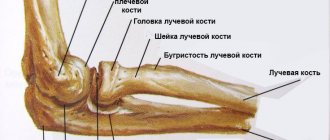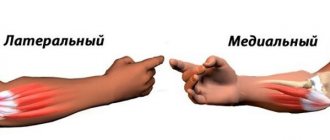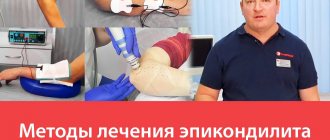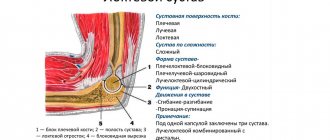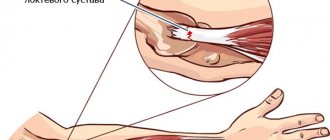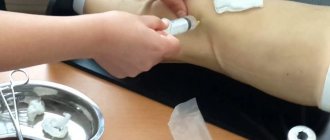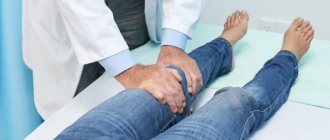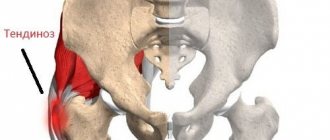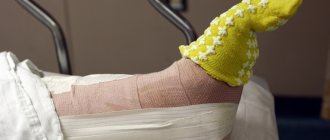Olecranon bursitis is a condition characterized by tissue damage and inflammation of the olecranon bursa (a small fluid-filled sac located at the back of the elbow), which can be a source of pain in the back of the elbow.
The elbow is formed by the union of the humerus and the ulna of the forearm. The ulna has a bony protrusion located at the back of the elbow known as the olecranon. This bony protrusion is the attachment point for several muscles, including the triceps, and forms the outermost point of the back of the elbow. Between the olecranon and the overlying skin is the olecranon bursa. The bursa is a small sac filled with liquid - a lubricant and its function is to reduce friction between adjacent layers of soft tissue.
The triceps muscle is primarily responsible for straightening the elbow and is especially active during pushing activities. During contraction of the triceps, friction is directed towards the ulnar bursa. Pressure on the olecranon bursa can also occur due to a direct blow. When this pressure on the bursa is excessive due to too frequent movements or the application of force, conditions arise for inflammation of the olecranon bursa.
Causes of Elbow Arthritis
It is extremely important for the patient to determine the causes of arthritis in the elbow joint. Some types of disease (for example, reactive arthritis) are very important to stop at the first symptoms of inflammation - then the disease can be completely cured, preventing structural changes in the joint and the transition of arthritis to the chronic stage.
However, most arthritis is a lifelong diagnosis. For a favorable prognosis for arthritis of the elbow joint, early diagnosis and regular visits to the doctor in compliance with medical recommendations are required.
Rheumatologists name the following causes of inflammation in the elbow:
- Post-traumatic
. Even a not too painful bruise on ice can provoke a rupture of a vessel, damage to a ligament, or disruption of the innervation of the joint. If inflammatory symptoms do not go away 2-3 weeks after the injury, rush to the emergency room or to a rheumatologist - if you wait until it “goes away on its own,” the damage may take years to affect. Note that injury can be acute (such as from an accident or surgery) or chronic (due to intense unnatural stress on the joint - such as athletes, loaders and other professionals). - Immune disorders
. In autoimmune diseases (such as rheumatism and rheumatoid arthritis of the elbow joints, systemic lupus erythematosus, type 1 diabetes mellitus, psoriasis), killer cells attack the connective tissue and the joint itself, which leads to a chronic focus of inflammation. Symptoms of arthritis increase after stress, hypothermia and prolonged exposure to the sun, allergies. - Hormonal changes in the body
. These can be either natural changes in hormonal levels (menopause in men and women), or hormonal disruptions and even endocrine diseases (for example, Graves' disease - hyperthyroidism). - Infectious diseases
. Measles, brucellosis, gonorrhea, syphilis, tuberculosis (especially dangerous for children), mycoplasmosis, chlamydia and other infections can cause complications in the joints. Nonspecific purulent infections, which can be caused by staphylococci, streptococci, and some intestinal pathogens, are also dangerous for the elbow joint. The infection can be either systemic (whole body) or local (for example, from an animal bite). Constant inflammation is also possible due to constant infectious foci in the body (caries, chronic cystitis, tonsillitis and others). - Metabolic disorders
. With metabolic disorders, undesirable metabolites (metabolic products) may accumulate in joints and soft tissues. For example, with gout, uric acid crystals constantly injure the articular surface and periarticular tissues. - Age-related changes in the joint
. Patients over 60 years of age often experience arthrosis-arthritis, a pathology in which structural changes in the joint (thinning of the cartilage layer, osteophytes) and insufficient production of synovial life cause mechanical irritation of the soft tissues. The consequence of such joint deformation is chronic arthritis.
The risk of arthritis of the elbow joint is most increased by recent infectious diseases of the respiratory, genitourinary and digestive systems, as well as sports and household injuries. Malignant tumors are the rarest cause of pain in the elbow joint.
Bursitis is the main thing
This is an inflammation of the bursa (bursa), a special protective structure of the joint. It has a fairly strong shell on the outside, consisting of connective tissue fibers. It serves to cushion the joint and protect the joint from external influences - shocks, injuries. The inner surface contains cells that secrete synovial fluid - a special lubricant to improve gliding in the joint and prevent wear of the heads of the bones. The second important function of intra-articular fluid is the nutrition of cartilage and bone tissues, which do not have their own blood vessels, and the necessary microelements are obtained from the lubricating fluid.
The elbow is a common place where this pathology occurs. This is a complex joint with a high intensity of movement and load and three joint capsules, each of which can be inflamed.
During the inflammatory process, the fluid in the joint increases in volume, its composition changes - it contains more protein, calcium salts, traces of blood and pus appear (with purulent inflammation). The elbow swells, movement in it becomes painful, limited, and performance is impaired.
Symptoms of Elbow Arthritis
The most specific sign of elbow arthritis is the accumulation of fluid (exudate) in the joint capsule. It seems to “stretch” the joint and put pressure on the soft tissues, causing a feeling of stiffness, bursting pain and insufficient nutrition of the tissues.
Correctly recognizing the symptoms of elbow arthritis helps you begin treatment on time.
Common signs of elbow arthritis
- swelling of the joint and surrounding areas;
- pain when touched and other inflammatory symptoms (redness of the skin over the elbow joint, local increase in temperature);
- disruption of normal mobility in the joint (as if something is preventing you from bending and unbending your arm, rotating it at the elbow) - stiffness, which over time turns into stiffness;
- weather sensitivity (the joint “twists” when the weather changes);
- specific clicks, especially during sharp flexion and extension;
- a gentle attitude towards the hand, an involuntary desire to keep it in a half-bent state.
Somewhat less common are numbness, itching, convulsive twitching and other involuntary muscle movements, and sleep disturbances.
For arthritic pain in the elbow joint, it is significant that at rest they do not disappear, but only intensify.
Specific symptoms of elbow arthritis
The specifics of the pain syndrome may differ depending on the causes of inflammation - with gout and psoriasis, the pain is dull and aching, with rheumatoid and purulent arthritis it is acute, preventing movement. With post-traumatic arthritis, pain may be subtle and give way to a feeling of heaviness and discomfort.
For acute purulent arthritis of the elbow joint, there are special signs:
- pain appears suddenly - yesterday it was not there, but today it is already painful;
- general body temperature rises;
- patients complain of headaches, aching muscles and joints, weakness, dizziness and fever;
- severe nausea may progress to vomiting;
- there is severe swelling;
- the patient gets tired quickly and may lose appetite and weight.
With specific infections and tumors, malaise and joint pain are accompanied by other symptoms - for example, exhaustion, bloody cough.
Purulent and reactive arthritis of the elbow joint is characterized by an aggressive course. In the early stages, the disease can be controlled with antibiotics. If left untreated, the symptoms of arthritis of the elbow joint rapidly increase - up to the need for surgical intervention and irreversible changes in the joint.
Prevention
Preventive measures are quite simple, however, many people neglect them. Before starting sports training, a full warm-up is necessary so as not to load unheated muscles. A light massage is helpful. Strength training is indicated to strengthen the elbow tendons. People who are at risk due to their profession need to promptly and correctly treat chronic infections that can cause complications in the form of epicondylitis. For proper functioning of the ligaments, it is recommended to take a B complex of vitamins and vitamin C.
Stages of elbow arthritis
Determining the stage of the inflammatory process is one of the key tasks in the diagnostic examination and treatment of pain in the elbow joint. For this task, X-rays of the elbow joint in various projections, ultrasound, and occasionally MRI are used (for clarification).
There are 3 main stages of elbow arthritis:
Stage 1
Elbow pain may be absent or appear irregularly - mainly in the morning, after stress or intense load on the joint. Mild swelling may be palpable. The patient may notice a feeling of heaviness without attaching much importance to it. The range of motion is fully preserved, and morning stiffness goes away after a short warm-up. Already at this stage, a laboratory blood test can reveal an increased content of red and white blood cells.
Stage 2
Pain and swelling are noticeable and cause anxiety to the patient. There is stiffness in the joint, up to the inability to fully bend or straighten the arm. Innervation of the limb decreases, and gradual muscle atrophy begins over time. Fine motor skills deteriorate and a crunching sound appears. The patient is capable of self-care, but already experiences some limitations at home.
Stage 3
The last stage is characterized by irreversible changes in the joint - deformations, persistent contractures. The patient can hardly move his arm at the elbow and suffers from continuous pain. His condition can only be alleviated surgically.
Diagnostics
Which specialist should I contact for elbow bursitis? Diagnosis, treatment and prevention are carried out by an orthopedic traumatologist, sometimes with the participation of an immunologist or endocrinologist.
The algorithm used is:
- Inspection and palpation of the affected and opposite joint.
- Tests to determine joint mobility and the volume of accumulated fluid.
- Ultrasound or MRI to evaluate soft tissues, search for pathologies, and assess the structure of inflammation.
- Puncture and analysis of synovial fluid to look for a possible infectious cause of inflammation.
- X-ray examination of the joint to assess its condition and search for possible pathologies.
The specific list of necessary studies is determined by the doctor during the consultation. All examinations can be completed at the clinic on the day of treatment in order to immediately receive a diagnosis and recommendations for treatment.
Treatment of elbow arthritis
In the early stages of arthritis of the elbow joint, conservative treatment methods are effective - taking medications, physical therapy, therapeutic exercises, and following a special diet. The last stage and advanced infectious arthritis of the elbow require radical solutions.
In the acute phase of the disease, it is important to avoid any stress on the joint, so doctors recommend wearing an immobilizing splint and a bandage across the neck.
Before treating elbow arthritis that has arisen as a secondary disease, consult a doctor about the primary one.
Treatment of elbow arthritis requires an integrated approach
Physiotherapy for elbow arthritis
After relief of acute symptoms of elbow arthritis, it is recommended:
- acupuncture;
- massotherapy;
- magnetic therapy;
- kinesitherapy and therapeutic exercises;
- phonophoresis;
- electrophoresis;
- laser therapy;
- amplipulse;
- paraffin applications, ozokerite, mud therapy.
For tuberculous and tumor arthritis and pregnancy, physiotherapy is not performed.
Massage for arthritis of the elbow joint
Massage of the elbow joint is carried out only when the inflammatory process subsides. It promotes speedy rehabilitation and restoration of elbow mobility. Therapeutic massage is especially effective after prolonged immobilization (for example, after wearing a cast for a broken arm). In this case, it helps strengthen weakened muscles and prevent relapse.
In the absence of pain and fever, patients can engage in warming self-massage - it is especially effective in combination with ointments, gels and creams against arthritis. The simplest methods are:
- circular movements along the shoulder and forearm with the pads of the fingers;
- stretching movements with the edge of the palm along the muscles of the arm;
- light pinching;
- stroking (including zigzag);
- shaking.
The massage should be light. Avoid massaging the joint itself for more than 1-2 minutes.
Exercise therapy for arthritis of the elbow joint
Therapeutic exercise helps to consolidate the effect of other types of treatment for arthritis of the elbow joint, strengthen the muscles, and make movements freer. Patients are recommended to perform simple exercises for arthritis of the elbow joint:
- bending the elbow with muscle tension - overcoming moderate resistance from the other hand;
- rotational movements in the elbow clockwise and counterclockwise;
- exercises with the ball (rolling on the table towards and away from you, throwing and catching a projectile);
- abduction of straight arms with dumbbells weighing up to 1 kg.
Swimming is also recommended for patients with elbow arthritis.
Avoid sudden movements during therapeutic exercises. Stop the exercise immediately if pain occurs.
Surgical treatment of elbow arthritis
For infectious arthritis, minimally invasive interventions are often used, such as puncture or drainage. They allow you to remove excess exudate from the elbow joint, restore its nutrition and mobility.
If conservative treatment is ineffective, the doctor may prescribe a synovectomy (partial excision of synovial cartilage, less often cartilage and subchondral bone). Removal of the problem area is usually indicated for tuberculosis and other specific joint lesions, as well as rheumatoid arthritis. With a favorable outcome, the synovial membrane is restored over time. If a large area had to be removed, the cartilage tissue is usually prosthetic. Synovectomy helps relieve pain and improve elbow mobility.
In exceptional cases - for example, with ankylosis - joint replacement may be required.
Causes of epicondylitis
Epicondylitis begins with daily monotonous flexion and extension of the elbow joint with a load on the arm, which overloads the tendons and causes tissue microtrauma. Due to its high prevalence among athletes, epicondylitis is also called “tennis elbow.” In addition to tennis, this disease can be triggered by sports such as lifting weights, wrestling, boxing, and golf. This disease is also typical for workers in the construction industry and agriculture. If you are a member of one of these professions, you need ongoing preventative measures to prevent elbow epicondylitis in time.
Medicines to treat elbow arthritis
Drug treatment of elbow arthritis in the acute phase involves taking anti-inflammatory and painkillers, and in the presence of infection, antibiotics.
Chondroprotectors
Chondroprotectors can be used both in acute and chronic periods. They improve metabolism and nutrition of cartilage tissue, prevent its destruction and promote regeneration.
Effective drugs with chondroitin and glucosamine sulfate: artracam, arthra, dona, structum, teraflex, chondrolone.
Anti-inflammatory and painkillers
Non-steroidal anti-inflammatory drugs are used to relieve inflammation and pain. For example: aspirin, indomethacin, nimesil, ibuprofen, piroxicam, ketoprofen, meloxicam, diclofenac and others. Such medications for the treatment of arthritis of the elbow joint are used in a complex manner - internally (in tablets, capsules, injections) and externally (gels, creams, ointments).
If NSAIDs are ineffective, in severe cases, glucocorticoids (corticosteroids) are prescribed in courses: triamcinolone, hydrocortisone, prednisolone, methylprednisolone, Detralex, Kenalog.
Antispasmodics
To eliminate spastic pain (for example, in rheumatoid arthritis), the following are indicated: mydocalm, pentalgin, fanigan, citramon, papaverine.
Vasodilators
To improve blood circulation, metabolism and tissue trophism, warming and irritating agents for external use are used - viprosal, nicoflex, menovazin. Dimexide is usually used in the form of compresses. You can give the elbow joint baths with bischofite.
Also effective are ointments with bee venom - episartron, ungapiven, virapin, and tablets - trental, pentoxifylline.
Did our article on symptoms and treatment of elbow arthritis help you? We hope so. Do not be ill!
Images designed by Freepik
Possible complications
Often, ignoring symptoms or trying to diagnose elbow bursitis on your own leads to serious consequences. Untimely treatment can lead to the formation of other ailments, such as:
- lymphangitis - inflammation of the lymphoid ducts is accompanied by the appearance of red lines in the affected area;
- lymphadenitis - damage to the lymph nodes;
- purulent arthritis - the development of inflammation spreading to other joints.
In addition, ignoring elbow bursitis can lead to inflammation becoming severe. In addition to painful consequences, this will complicate diagnosis and treatment.
